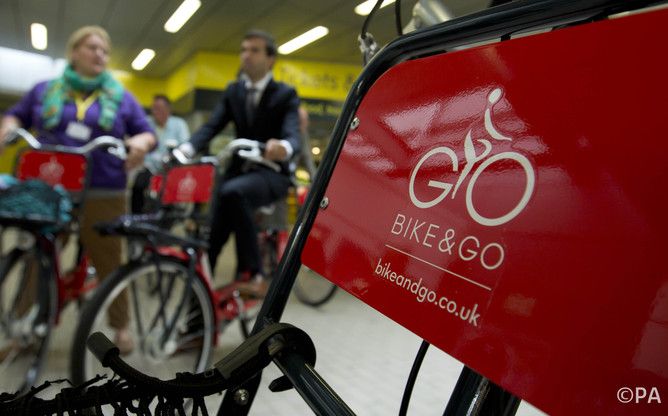
Can Bikeshare Systems Ever Stand on Their Own Two Wheels? (Op-Ed)

This article was originally published at The Conversation. The publication contributed the article to Live Science's Expert Voices: Op-Ed & Insights.
In countries across the world, what can only be described as a bikesharing boom is taking place, with systems operating in 686 towns and cities worldwide, from Aspen, Colorado to Zhuzhou, China.
Despite their apparent popularity however, they are not without their problems. The London scheme lost its main sponsor late last year when Barclays declined to renew its funding, and the biggest equipment provider for bikesharing programs in the US, the Canadian firm Public Bike System Company (PBSC), recently filed for bankruptcy protection.
Individual schemes have specific problems, but these developments do prompt the question: what does it take for a bikesharing system to be economically viable, if indeed that’s possible?
Whether a bikesharing system can stand financially on its own two wheels depends on a number of factors – and different markets have different needs. More than 50% of members from the publicly funded Capital Bikeshare in Washington, DC use the system to access other forms of public transportation, according to a member survey from 2013. Yet data collected by Rui Wang and Chen Liu at the University of California, Los Angeles suggest that bikesharing can function as a viable means of public transit even without rail or bus networks.
As a mode of public transport, a bikesharing system would require public subsidy to support capital investment. The reality, however, is that public funding is not always available, which means many town councils and city authorities have left funding to the operators and equipment suppliers.
In some cases, it may be possible that a bikesharing system could be supported entirely through private sponsorship and user fees. To date, very few programs have managed that, with few models generating sufficient income to be profitable across the service area. New York City’s Citi Bike, North America’s largest bikesharing system that launched in Summer 2013, has not turned a profit despite sponsorship of US$46m from Citibank and MasterCard and a turnover of millions of dollars in fees. But more time is needed to better understand its economic viability, since the system has only been in operation about seven months.
Sign up for the Live Science daily newsletter now
Get the world’s most fascinating discoveries delivered straight to your inbox.
The sponsorship-based bikesharing model still remains relatively unproven, but several other cities in the US have followed suit – largely due to dwindling city transportation budgets. Those cities include Portland, Oregon; Atlanta, Georgia; Providence, Rhode Island; and Orlando and Tampa, Florida – all expected to launch a service this year.
Kansas City B-cycle, owned and operated by a not-for-profit company, recently turned to the internet for funding. The organisation used a crowdsourced funding page to raise cash to purchase more equipment to expand the system. And while a similar attempt last year fell short of its goal, the current round has managed to raise more than US$300,000.
In Paris, the renowned Vélib’ system is powered by an advertising model. Funding for the service comes from the media giant JC Decaux, which in exchange is awarded advertising rights to all the city’s bus shelters. As the name suggests, the London Barclays Cycle Hire was funded through sponsorship from the bank, but its departure leaves the system’s future in question after the current contract expires in 2015. Outside of Paris and London, most European cities fund their bikesharing programs through public subsidy.
On the other side of the world, bikesharing programs in Asia – and in China in particular – have been quietly outpacing the rest of the world. Such systems, also popular in Japan and South Korea, rely almost entirely on public subsidy. In China, all of the nation’s 164 schemes and estimated fleet of 358,000 bikes are publicly owned. The world’s largest schemes, in Wuhan in central China and Hangzou on the east coast, have around 90,000 and 70,000 bikes, respectively (compared to 20,000 in Paris).
In Taiwan, the country’s premier recently encouraged cities to pursue bikesharing programs, but he cautioned that they could not all expect to enjoy government subsidy. And in other cities, like Pasig City in the Philippines, the Asian Development Bank has helped fund the country’s first bikesharing system, Tutubi (“dragonfly”).
The economic viability of bikesharing programs is a question of circumstance and intent. A business model proven to work in Miami Beach or New York may not work in Minneapolis or Salt Lake City. Regardless of circumstance, if a city intends to create a bikesharing service that will add another layer to their public transport system for all to use, it will probably require some level of public subsidy. Programs that are entirely privately funded tend to deploy equipment in affluent neighbourhoods and tourist destinations where they will see plenty of use, but they may also exclude low-income parts of town.
Having said that, any financial stake a local government authority has in a system through provision of public subsidy can also provide a greater say over where bikes and stations are set up, pricing levels, and how to most effectively integrate the bikes into existing public transportation networks to foster the public good.
Susan Shaheen receives funding from the Mineta Transportation Institute, which is a University Transportation Center (funded by the US Department of Transportation and Caltrans) to conduct research on public bikesharing.
Matthew Christensen does not work for, consult to, own shares in or receive funding from any company or organisation that would benefit from this article, and has no relevant affiliations.
This article was originally published on The Conversation. Read the original article. The views expressed are those of the author and do not necessarily reflect the views of the publisher. This version of the article was originally published on Live Science.












